No, You Won't Get Bulky Thighs—4 Spin Myths We're Debunking Right Now

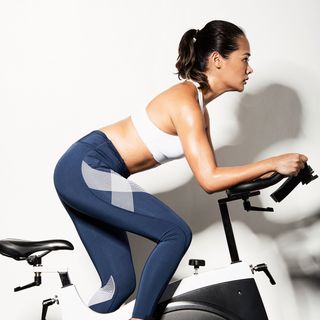
I am fully aware of the many misconceptions surrounding indoor cycling, because I have personally fallen victim to them many times over. True story: En route to my first SoulCycle class several years ago, I was so nervous that I felt physically ill. As someone who really despised cardio for many years and was still overwhelmed by the newly burgeoning boutique fitness scene in NYC—and the notoriously cult-like fervor of places like SoulCycle—I was incredibly overwhelmed.
Spoiler alert: Five minutes into class, all that anxiety had melted away as I picked up on the lingo, realized no one cared how precise my tap-backs were, and fell into the groove of the pounding music. But when I was in Paris a few weeks ago to explore the wellness scene, I felt that old intimidation resurface as I stepped into one of the popular cycling studios there. Even if it only took a matter of seconds to remember yet again that I actually like indoor cycling, clearly these misconceptions are persistent.
And if there's anything I've learned in confiding these things to my friends over the years, it's that I'm not alone. Spin is polarizing in a peculiar way, in that many of the people I know who claim not to like it have only tried it once or twice (if at all). And these same people recite the same myths I have found myself debunking through personal experience again and again. So in an effort to clear the air once and for all, I deferred to Peloton instructor Jennifer Jacobs. Below, she address some of the most popular spin class myths, from how it affects muscle tone in our legs to the intimidation factor.
Myth #1: Your legs will bulk up.
"It is definitely not true," says Jacobs. "Cycling helps strengthen and tone your legs without adding bulk. I think people think it will add bulk because when they think of cycling, they're thinking that you use your legs to push and pull on the pedals." But really, she says, it's not that different from running—and does anyone ever blame running for making their legs look bulky? (Fair point.)
If you want to dive into the specifics of this myth, Jacobs says to consider the movement of our legs during cycling. "When you cycle correctly, you are making fluid circular motions, not up-and-down movements," she says. "In order to bulk up or gain muscle, you would need to use incredibly high resistance for very short period of time just as one would do when strength training (heavy weights, low reps) to attempt to increase the size of one's legs, not to mention increase their caloric intake to put on size."
Myth #2: It's too intense.
A word to the wise: There's no better environment than a dark studio with loud music packed with people focusing on their own rides to modify your own if necessary—not to mention a handy resistance knob that you can discreetly adjust if you're feeling self-conscious. In other words, the class can be as intense as you want it to be.
"Just because you're riding in a group does not mean that you cannot individualize your ride," says Jacobs. "The instructor is there to guide you, but you know yourself the best and know how much to increase the resistance to challenge you at your own level. Remember that a resistance that challenges you may not be the same resistance that challenges the person next to you."
Myth #3: It'll get boring after a while.
If you're concerned that your body won't feel challenged or that the workout will feel too consistent after several classes, know that the best cycling instructors will switch up their class plans constantly to keep you engaged. But if you're really looking for a shift, you might consider trying a bunch of different instructors—or better yet, a different class variation if that's available to you.
"I teach a variety of classes designed to challenge your body and your mind in different ways such as HIIT, climb, Tabata, speed, low-impact, endurance, etc.," says Jacobs. "For example, during a 90-minute endurance ride, I will challenge you to hold resistance or cadence for certain lengths of time, which will improve your stamina and test your ability to remain focused.
"This is as challenging of an effort for the body as running a half marathon yet remains low-impact on the joints so that you can challenge yourself in a different way the next day. If going the distance is not challenging for you, a HIIT or Tabata ride will test your limits and improve your strength without having to do another set of burpees!"
Myth #4: Everyone in class knows what they're doing, and I don't.
See the answer to Myth #2 above, and also keep in mind that if it's your first spin class ever, picking up the lingo (and getting clicked into your bike) is a one-and-done deal: Once you know, you're prepared for all future cycling classes. You'll likely have to sign a waiver if it's your first time anyway, so your instructor and/or the attendants at the front desk will be happy to show you the ropes. In terms of looking like you belong (which is valid—gym-timidation is real), consider the words of a wise poet: "Lose yourself in the music." Most cycling classes are glorified dance parties, so just try to stick to the rhythm and above all else, have a blast.
Disclaimer
This article is provided for informational purposes only and is not intended to be used in the place of advice of your physician or other medical professionals. You should always consult with your doctor or healthcare provider first with any health-related questions.
-
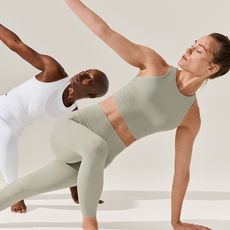 I Live for Yoga and Pilates—These Are the Pieces That Help My Flow
I Live for Yoga and Pilates—These Are the Pieces That Help My FlowTake notes.
By Humaa Hussain
-
 It's Time to Get Our Nutrition in Check for Summer—This App Is Making It Easy
It's Time to Get Our Nutrition in Check for Summer—This App Is Making It EasyThe recipe ideas are endless.
By Who What Wear
-
 If You're Battling With Digestive Issues, This Could Be Why
If You're Battling With Digestive Issues, This Could Be WhyTurns out, you may not have IBS after all.
By Kia Topps
-
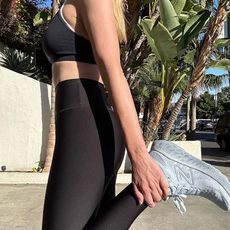 Our Editors Own a Lot of Sneakers, But This Pair Comes in First Place Every Time
Our Editors Own a Lot of Sneakers, But This Pair Comes in First Place Every TimeA major win.
By Aniyah Morinia
-
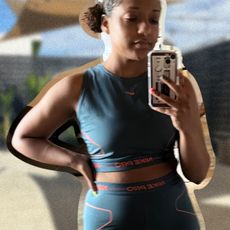 I Changed My Mind About Strength Training When I Tried This Workout
I Changed My Mind About Strength Training When I Tried This WorkoutMy confidence is officially on 10.
By Kia Topps
-
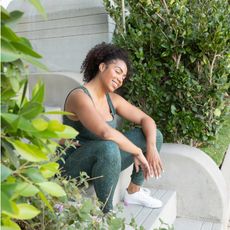 This Type of Gear Will Take Your Workout to the Next Level
This Type of Gear Will Take Your Workout to the Next LevelBring it on.
By Sarah Yang
-
 6 Essential Oils That Will Heal Your Painful Sunburns
6 Essential Oils That Will Heal Your Painful SunburnsAll-natural relief ahead.
By Samantha Parsons
-
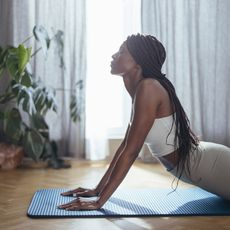 The Activewear Accessory That Can Change Your Yoga Practice
The Activewear Accessory That Can Change Your Yoga PracticeIt's so helpful.
By Sarah Yang

